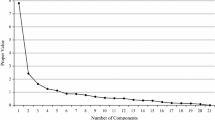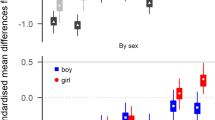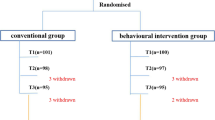Abstract
Purpose
Several studies of school-aged children with attention deficit hyperactivity disorder (ADHD) have found a higher prevalence of overweight/obesity compared with the general population. However, the scientific literature contains insufficient evidence to establish clear conclusions on pulmonary functions, resting metabolic rate (RMR), and body composition in children with ADHD. This study therefore investigates the pulmonary functions tests (PFTs), RMR, and body composition parameters in children with ADHD and evaluates their quality of life.
Methods
Forty children with ADHD and 40 healthy controls participated in the study. The children’s parents completed Conners’ parent rating scale (CPRS) and the pediatric quality of life (PedsQL), and their teachers completed Conners’ Teacher rating scale (CTRS). The child participants also completed the PedsQL. RMR, PFTs, and body composition parameters were investigated.
Results
No significant differences in age, gender, and socioeconomic level were found. All CPRS subscales, except anxiety and psychosomatic conditions, were significantly different (p < 0.05). According to the CTRS, inattentiveness, hyperactivity, and conduct problems were significantly higher in the ADHD group. The results showed that the ADHD group’s quality of life is worse than the control group. Body mass index, body composition parameters, RMR, and PFTs were not statistically different between the children with ADHD and the healthy controls.
Conclusions
Further studies with complex designs are needed to confirm the results.
Similar content being viewed by others
References
Polanczyk G, De Lima MS, Horta BL et al (2007) The worldwide prevalence of ADHD: a systematic review and metaregression analysis. Am J Psychiatry 164:942–948. doi:10.1176/appi.ajp.164.6.942
Skounti M, Philalithis A, Galanakis E (2007) Variations in prevalence of attention deficit hyperactivity disorder worldwide. Eur J Pediatr 166:117–123. doi:10.1007/s00431-006-0299-5
Dubnov-Raz G, Perry A, Berger I (2011) Body mass index of children with attention-deficit/hyperactivity disorder. J Child Neurol 26:302–308. doi:10.1177/0883073810380051
Polanczyk G, Casella E, Miguel E, Reed U (2012) Attention deficit disorder/hyperactivity: a scientific overview. Clinics 67:1125–1126. doi:10.6061/clinics/2012(10)01
Mulqueen JM, Bartley CA, Bloch MH (2013) Meta-analysis: parental interventions for Preschool ADHD. J Atten Disord. doi:10.1177/1087054713504135
Holtkamp K, Konrad K, Muller B et al (2004) Overweight and obesity in children with attention-deficit/hyperactivity disorder. Int J Obes Relat Metab Disord 28:685–689. doi:10.1038/sj.ijo.0802623
Cortese S, Angriman M, Maffeis C et al (2008) Attention-deficit/hyperactivity disorder (ADHD) and obesity: a systematic review of the literature. Crit Rev Food Sci Nutr 48:524–537. doi:10.1080/10408390701540124
Hubel R, Jass J, Marcus A, Laessle RG (2006) Overweight and basal metabolic rate in boys with attention-deficit/hyperactivity disorder. Eat Weight Disord 11:139–146. doi:10.1007/bf03327559
Ebenegger V, Marques-Vidal P-M, Munsch S et al (2012) Relationship of hyperactivity/inattention with adiposity and lifestyle characteristics in preschool children. J Child Neurol 27:852–858. doi:10.1177/0883073811428009
Curtin C, Bandini LG, Perrin EC et al (2005) Prevalence of overweight in children and adolescents with attention deficit hyperactivity disorder and autism spectrum disorders: a chart review. BMC Pediatr 5:48. doi:10.1186/1471-2431-5-48
Biederman J, Faraone SV, Monuteaux MC et al (2003) Growth deficits and attention-deficit/hyperactivity disorder revisited: impact of gender, development, and treatment. Pediatrics 111:1010–1016. doi:10.1542/peds.111.5.1010
Salome CM, King GG, Berend N (2010) Physiology of obesity and effects on lung function. J Appl Physiol 108:206–211. doi:10.1152/japplphysiol.00694.2009
McGee R, Birkbeck J, Silva PA (1985) Physical development of hyperactive boys. Dev Med Child Neurol 27:364–368. doi:10.1111/j.1469-8749.1985.tb04548.x
Conners CK (1989) Manual for Conners’ rating scales. Multi-Health Systems. Toronto
Varni JW, Seid M, Rode CA (1999) The PedsQL: measurement model for the pediatric quality of life inventory. Med Care 37:126–139. doi:10.1097/00005650-199902000-00003
Üneri Ö, Çakın Memik N (2007) Concept of quality of life in children and review inventories about quality of life. Turk J Chıld Adolesc Ment Health 14:48–56
Dereboy Ç, Şenol S, Şener Ş, Dereboy F (2007) Validation of the Turkish versions of the short-form Conners’ Teacher and Parent Rating Scales. Turk Psikiyatr. Derg. 18:48–58
Sener S, Dereboy C, Dereboy IF, Sertcan Y (1995) Conners’ Teacher Rating Scale Turkish version-I. Turk J Child Adolesc Mental Health 2:131–141
Ucok K, Aycicek A, Sezer M et al (2011) Resting metabolic rate and anthropometric measurements in male sleep apnea patients. Intern Med 50:833–838. doi:10.2169/internalmedicine.50.4779
Üçok K, Dane Ş, Gökbel H, Akar S (2004) Prevalence of exercise-induced bronchospasm in long distance runners trained in cold weather. Lung 182:265–270. doi:10.1007/s00408-004-2503-6
Sevinç Ö, Bozkurt Aİ, Gündoğdu M et al (2011) Evaluation of the effectiveness of an intervention program on preventing childhood obesity in Denizli, Turkey. Turkish J Med Sci 41:1097–1105. doi:10.3906/sag-1009-1179
American College of Sports Medicine (2013) ACSM’s guidelines for exercise testing and prescription. Lippincott Williams and Wilkins
Cortese S, Moreira-Maia CR, St. Fleur D et al (2015) Association between ADHD and obesity: a systematic review and meta-analysis. Am J Psychiatry appi.ajp.2015.1. doi:10.1176/appi.ajp.2015.15020266
van Egmond-Fröhlich AWA, Widhalm K, de Zwaan M (2012) Association of symptoms of attention-deficit/hyperactivity disorder with childhood overweight adjusted for confounding parental variables. Int J Obes 36:963–968. doi:10.1038/ijo.2012.78
Sawyer MG, Whaites L, Rey JM et al (2002) Health-related quality of life of children and adolescents with mental disorders. J Am Acad Child Adolesc Psychiatry 41:530–537. doi:10.1097/00004583-200205000-00010
Klassen AF, Miller A, Fine S (2006) Agreement between parent and child report of quality of life in children with attention-deficit/hyperactivity disorder. Child Care Health Dev 32:397–406. doi:10.1111/j.1365-2214.2006.00609.x
Yang P, Hsu HY, Chiou SS, Chao MC (2007) Health-related quality of life in methylphenidate-treated children with attention-deficit-hyperactivity disorder: results from a Taiwanese sample. Aust New Zeal J Psychiatry 41:998–1004. doi:10.1080/00048670701689451
Harding L (2001) Children’s quality of life assessments: a review of generic and health related quality of life measures completed by children and adolescents. Clin Psychol Psychother 8:79–96. doi:10.1002/cpp.275
Kendall J (1997) The use of qualitative methods in the study of wellness in children with attention deficit hyperactivity disorder. J Child Adolesc Psychiatr Nurs 10:27–38. doi:10.1111/j.1744-6171.1997.tb00419.x
Landgraf JM, Rich M, Rappaport L (2002) Measuring quality of life in children with attention-deficit/hyperactivity disorder and their families: development and evaluation of a new tool. Arch Pediatr Adolesc Med 156:384–391. doi:10.1001/archpedi.156.4.384
Tantillo M, Kesick CM, Hynd GW, Dishman RODK (2002) The effects of exercise on children with attention-deficit hyperactivity disorder. J Am Coll Sport Med 203–212. doi:10.1097/00005768-200202000-00004
Harvey WJ, Reid G (1997) Motor performance of children with attention-deficit hyperactivity disorder: a preliminary investigation. Adapt Phys Act Q 14:189–202
Acknowledgments
We thank the participants in the present study.
Author information
Authors and Affiliations
Corresponding author
Ethics declarations
Conflict of interest
The authors declare that they have no conflict of interest.
Ethical approval
The study was approved by the local ethics committee and adhered to the Declaration of Helsinki.
Informed consent
Informed consent was obtained from all individual participants included in the study.
Rights and permissions
About this article
Cite this article
Alpaslan, A.H., Ucok, K., Coşkun, K.Ş. et al. Resting metabolic rate, pulmonary functions, and body composition parameters in children with attention deficit hyperactivity disorder. Eat Weight Disord 22, 91–96 (2017). https://doi.org/10.1007/s40519-015-0241-9
Received:
Accepted:
Published:
Issue Date:
DOI: https://doi.org/10.1007/s40519-015-0241-9




